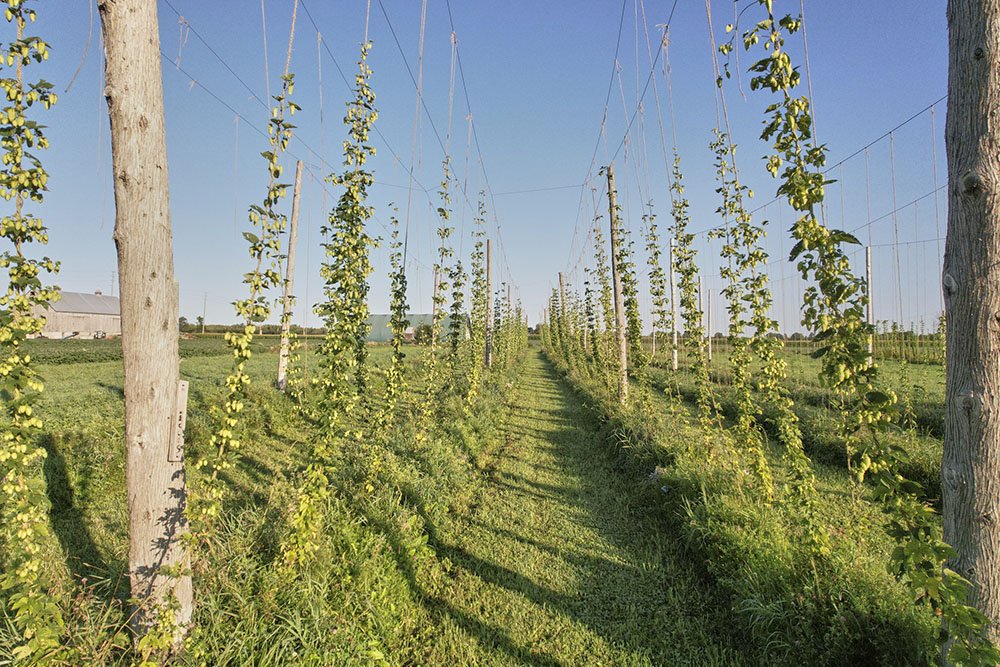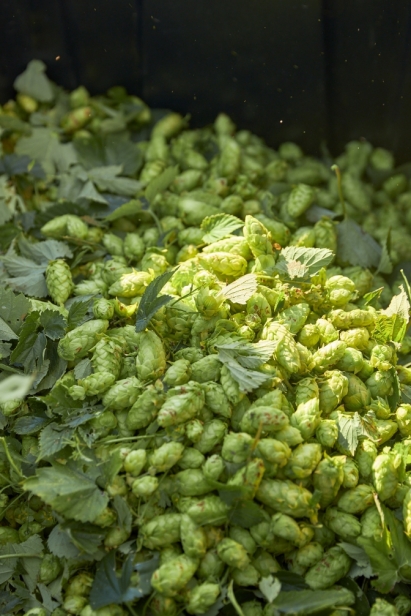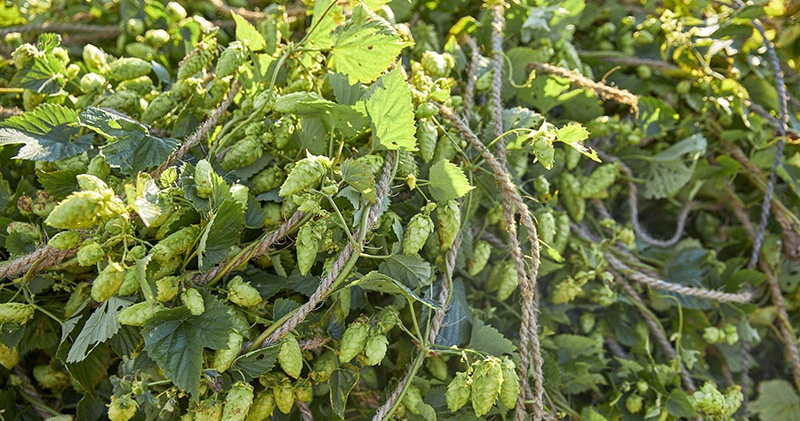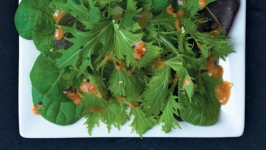A Home for Hops
As the micro-brewing industry in Ontario has taken off, demand for one its essential ingredients has grown, too. Not malted barley or wheat, but hops.
Hops are the flowers of the humulus lupulus, that unique vine with hairy, gripping tendrils that can climb any pole, piece of string, pergola or wall. The female plant produces strongly scented green, papery, pendulous flowers in late summer. Hops are used to flavour beer, primarily to introduce a bitter flavour note, and one layered with floral, fruity or citrus aromas, too.
At Battle House Hops in Almonte, the heart of the Ottawa Valley, Ian Murchison grows Galena, Cascade and Centennial hops on a 20-acre farm he bought in 2020.
“I saw growing hops as a way to support the beer industry,” he says. But it’s a long-term plan. The vines take about five years to get to maturity. Currently, he sells to Broadhead Brewing Company and Whiprsnapr Brewing Co.
Murchison, who grew up between Carleton Place and Carp and whose grandparents were farmers, has a day job with Nokia in Kanata, but his heart lies with hops. Battle House is located at a former government radio site Murchison bought from the RCMP. It still boasts the remnants of a former RCMP close quarters training building called a battle house, climbing walls, training tunnels, rope structures and water ditches around the property. But now Murchison is focusing on farming rather than military manoeuvres.
The first hops went into the ground in 2021 and now poles and string cover an acre. He’s planning to grow slowly, eventually expanding to 12 acres under cultivation as demand grows. But building a hop yard is a big undertaking. For just this one acre, there are more than 10,000 feet of cable strung high above the ground between 25-foot-tall cedar poles, and irrigation demands of about 1,000 litres of water daily between the spring runoff drying up and the fall harvest. In really hot weather, than number can jump to 3,000 litres daily. Clearly, making beer is thirsty work.
At harvest time in early September, Murchison is bringing in 330 pounds of hops, which need sorting to filter out everything except the cones. Following plans from the University of Vermont, Murchison, who has a background in industrial design, built his own hop machine, to separate the hop flowers or cones from the leaves and vines. This home-built machine would otherwise costabout $60,000 used. At his Ottawa home, he built the equivalent of a mini oast house, those round brick buildings with white wooden peaks that dot the southern English countryside, and which are the traditional way to dry hops. Murchison’s is a large cupboard layered with shelves fitted with a series of heaters and fans through which he moves the hops as they dry for 10 to 12 hours. “They smell great and very strong,” he says.
As soon as the hops are dry, Murchison puts them through the Hammermill to grind them to dust, then a small pelletizer machine, which compresses the hop dust into pellets. Next, he measures them out into 11-pound or half-pound bags — the smaller bags are ideal for home brewers and Battle House is one of the few producers to sell in small quantities — vacuum packs them with nitrogen for preservation and stores them in the freezer where they will last for up to two years. Lupulin, the active ingredient in hops, plays a large part in giving the plant its characteristic scents and flavours. It contains many of the acids and essential oils that make beer so delicious, but it smells horrible when it goes stale. Murchison also sells wet hops; these are whole cones that are dry, but not pellets. “It’s a specialized skill to brew with wet hops,” he explains, “and some breweries will do it for a special edition.”
Murchison chose Galena, the traditional bittering hop; Cascade, the traditional cornerstone hop with citrus and grassy notes; and Centennial, similar to Cascade with notes of pine, citrus and flowers, because “I want to see what the land gives us. Terroir has a big effect.”
Battle House Hops
6556 County Rd. 29, Almonte, Ont.
battlehousehops.ca | @battlehousehops
Stone Hedges’ hops
Further up the Ottawa Valley, just outside Pembroke, Margaret and Brian Leach came to hop-growing late in life. They are fifth-generation retired dairy farmers, who moved eight years ago to their seven-acre property with views of Lake Doré. “I thought my husband would be bored having given up the cows,” Margaret says, “so we decided we would give hops a try. The learning curve has been very steep.”
Their property, Stone Hedges, is a wedding venue with carefully curated hops as the backdrop. Rather than measuring their production by acreage, the Leaches measure by plants. To date, they have 600 in the ground, which include Cascade, Centennial, Chinook and a new variety from New Brunswick called Vista. “It’s like having a very large garden,” Margaret says, “because we have no machinery.”
In the spring, the couple spends an intense couple of weeks training the hops to wind up their strings and pruning suckers, to concentrate the growing and nutrients. Harvesting is done by hand, by tugging on the jute strings to bring the vines tumbling to the ground, where a team of friends and family gather them and sort by hand in exchange for a delicious lunch and a couple of beers. The cones are dried in two very small oasts made by a friend, then baled and frozen until Brian drives them to Port Hope to be pelleted and vacuum-packed.
Stone Hedges Hops sells to Perth Brewery, Cold Bear in Arnprior and a brewery in Mont Tremblant. “Small, artisan brewers are the most interested in buying local,” Margaret says.
Stone Hedges Hops
1239 Stone Hedges Rd., Eganville, Ont,
613.639.9099 | @stonehedgeshops
An Ontario-only initiative
Down on the St. Lawrence River on Wolfe Island, Grace Reeves and her husband John are building their own local hop economy. After just five years of production, they are already working with eight local breweries. John, who is on the board of the Ontario Hop Growers’ Association, is engaged in the launch of a new beer label, BrewON, which will be applied to beer brewed only using Ontario-grown ingredients. “Our hope is that we can all work together to really supply Ontario beer, showcasing Ontario flavours,” Grace says. “We should celebrate the fact that Ontario hops are very unique.”
After a holiday in Nova Scotia where John, a former horticulturalist, spied some hops in a fi eld, he was intrigued enough to research the plant, learning about the importance of “terroir” for hops and their need for wind and water. The couple bought the 61-acre farm in 2017. “I didn’t really understand what we were getting into at all,” Grace says. But soon enough, she did.
Grace, who was a food, gardening and design producer in Toronto for the Cityline show on CTV for 13 years, spent her weekends commuting from the city. The couple bought a trailer, which they parked on the property for their weekend overnights, then they built a Bunkie with a bathroom and kitchen. “We knew nobody on the island,” Grace recalls. “People thought we were crazy, especially as they saw hundreds of tall poles and kilometres and kilometres of wire coming across on the boat.” But they set out to build community and they have done this, hosting an annual farm-to-brewer day during the six-week late August, early September harvest season, in partnership with Hotel Wolfe Island and many of the breweries they supply.
In 2018, seven friends and family planted 6,000 hop seedlings, three feet apart, into compacted soil that had previously been used only for making hay. It was hard, physical work. They’ve chosen four varieties: Columbia, Crystal, Magnum and Kirin, an Asian variety used by Sapporo and grown nowhere else in North America. Magnum, which is used for bittering, “is the pepper to any recipe — add a little or a lot to impart a full flavour, clean, bitter taste,” says Grace. “We’ve been told that our Magnum hops taste unique. This may be due to our water, drawn from the river and the minerals in the soil here.”
Currently, the Reeves have seven acres planted, with a further eight ready to go, complete with poles and cables. This year, they brought in about 3,000 pounds of hops. “Our hope is that as recipes are developed by local brewers, we can plant other varieties that they’d like to use.”
During the pandemic, the Reeves sold their home in Toronto and bought the original farmhouse that had been severed from the land where their hops now grow. They live full time on the island with two children, both of whom help on the farm when not at school. They are regenerating an Ontario hop industry, so that local brewers can rest assured that there will be consistent supply. At present, Wolfe Island Hops can be found in beers from Karbon Brewing Co., Skeleton Park Brewery, Fine Balance Brewing Co. and Harrowsmith Brewing Co., among others.
“Basically we buy most of our hops back in liquid form,” Grace jokes. “We enjoy the beers that our hops help create.”
Wolfe Island Hopyard
5365 Rd. 96, Wolfe Island, Ont.
wolfeislandhopyard.com | 416.456.4875












